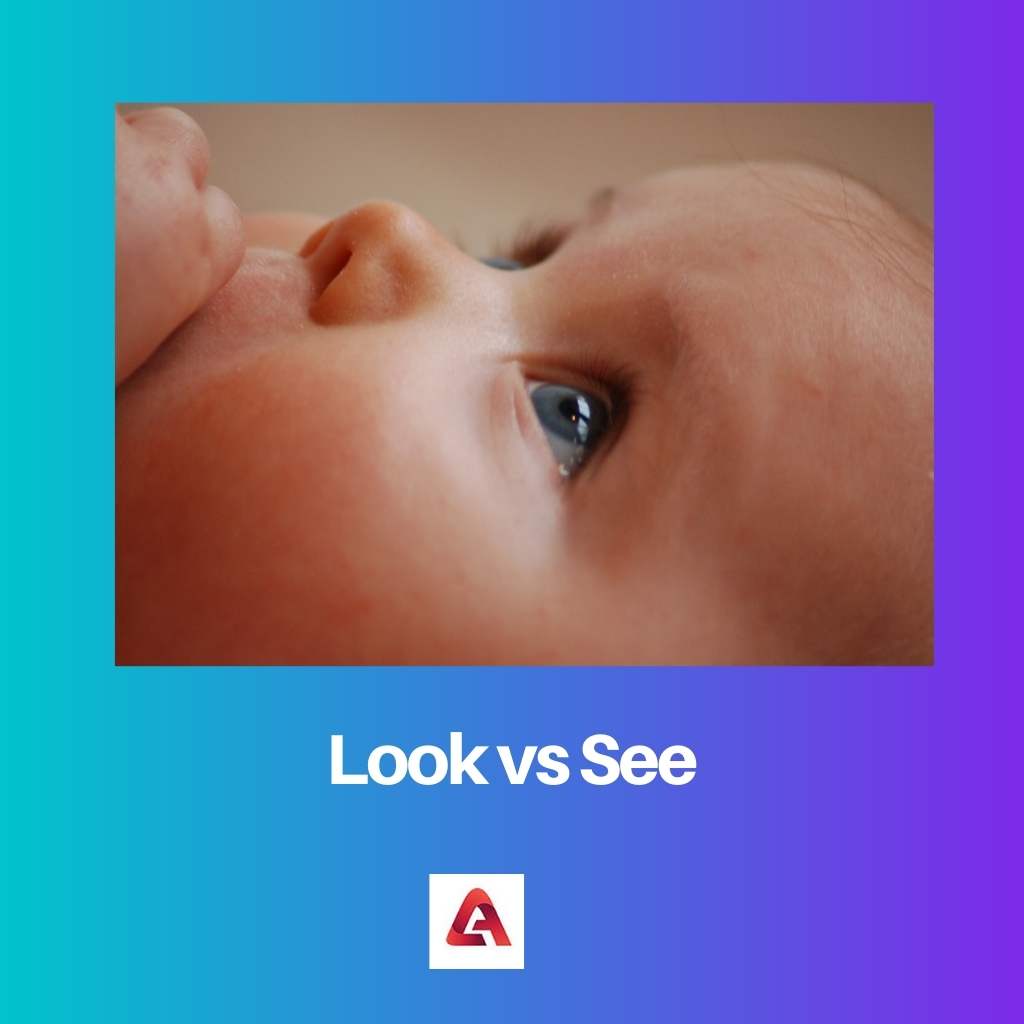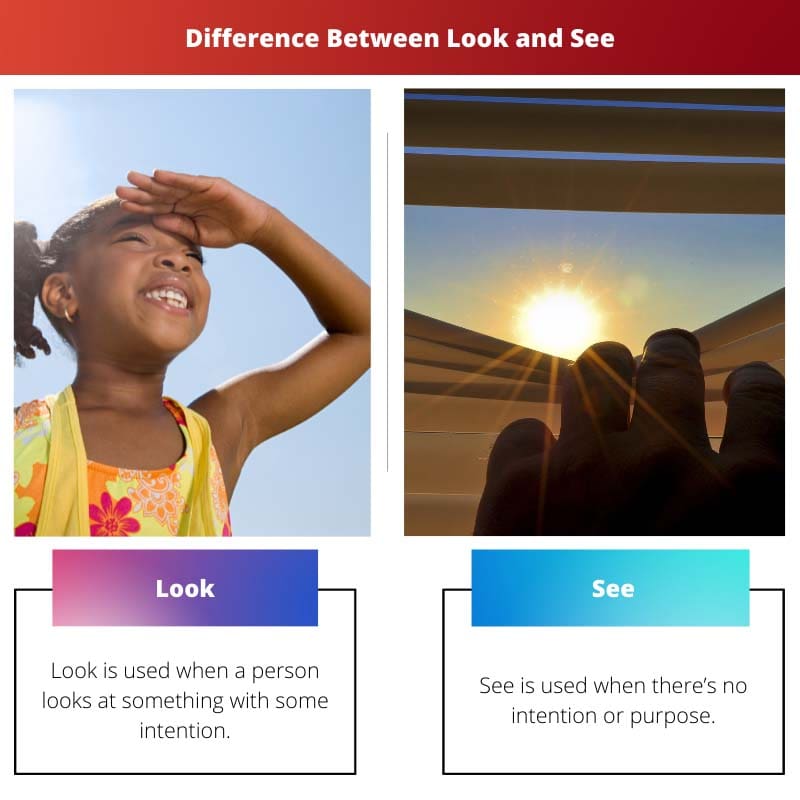If we talk about English words, then many such words have the same meaning, but their place of use is different.
Such words sometimes confuse us a lot, but before using any word, it is necessary to decide for what purpose that word is being used. So for that, we need to understand the difference between those words deeply.
For example, if we talk about the differences between look and see, both words are related to watching something, but yet they are quite different from each other.
Key Takeaways
- “Look” implies intentional observation, while “see” suggests passive perception of visual information.
- “Look” involves directing attention to something, while “see” denotes the actual reception of visual data.
- “Look” requires a conscious effort, while “See” occurs naturally without deliberate action.
Look vs See
Look means to direct one’s gaze to see something or the appearance of something or someone. It can also be to think of a thing in a specified way or to glance at something or in a direction. See is to perceive visually with the eyes or deduce or understand a thing after checking information or reflection.

Look means to look at something with some intention. To look at a particular thing, when we turn our eyes towards that thing, then this word is used for that attitude there.
Although we watch many things in our daily life, we forget because we do not pay attention to them. But if we look at something carefully, we remember that thing.
See means when our eyes suddenly fall on something or we see something without any intention. We see many such things in our everyday life, behind which we have no intention.
See is only used in places where there is no purpose. Seeing includes active recognition and understanding. One can look at what is lost but not see it.
Comparison Table
| Parameters of Comparison | Look | See |
|---|---|---|
| Definition | Look is used when a person looks at something with some intention. | See is used when there’s no intention or purpose. |
| Etymology | Look originated from west Germanic, locian, and German, lūgen. | See Originated from middle English, seen, and old English seõn. |
| Purpose | When you’re simply moving your eyes to some object or person or a place | When you simply happen to notice something. |
| Related terms | Look ahead, look up, look at are some of the related words to Look | See-through, see after, see to are some of the related words to See |
| Example | Look up ahead traffic is terrible. | I can’t wait to see my favourite band. |
What is Look?
Look means focusing on what you are looking for. “Look” is used when you give forceful attention to the object. It is used when one thing is to be seen. To “look” means to look at something with some intention, even if we have known it for a short time.
The first known use of look in the sense defined intransitive meaning 1 is as a verb before the 12th century. Whereas as a noun, the word was first used in the 13th century in the sense defined in meaning 1a.
If we talk about the history and etymology to look at, the word originated first from the word locian which is from Middle English and Old English. It also originated from West Germanic, German, and lūgen.
It is a kind of deliberate action. For example, you look at something that means you made your deliberating act. Gazing at something is also a part of this. It is more intentional or comes with a purpose which could be anything.
If we consider the definition of look, then according to Edward Glee, it is something to make an assurance on something which is done or censored, which confirms that no man is living idly.

What is See?
To “see” means to notice and be aware of an unknown thing or person with one’s own eyes. It is something that comes into our vision that we are not looking for.
Before this action, it creates an image in our eyes and brain from which we can see. Seeing means that we are looking, but our attention is not there. It is used where we are not focused. Seeing is considered a normal function of the eyes.
See means when our eyes suddenly fall on something or we see something without any intention. We see many such things in our everyday life, behind which we have no intention.
See is only used in places where there is no purpose. Seeing includes active recognition and understanding. One can look at what is lost but not see it. It is not a deliberate action.
For example, when we saw someone accidentally, we make a non-deliberating act. It is also sometimes used under intentional action, especially when it means ‘visited’. “Doctor seeing a patient” denotes a deliberate action, not accidental.
If we talk about the etymology of this word, then it is believed that this word has come from the word seen, which is from Middle English and seōn word of old English.

Main Differences Between Look and See
- Look is used when a person looks at something with some intention. See is used when there’s no intention or purpose.
- Look originated from West Germanic, locian, and German, lūgen.
- See Originated from middle English, seen, and old English seõn.
- The purpose of look is when you’re simply moving your eyes to some object or person, or a place.
- The purpose of seeing is when you simply happen to notice something.
- The look is a deliberate action, whereas the see is not a deliberate action. But sometimes the word see is used under deliberate action, especially when it means “visited”. The doctor seeing a patient” denotes a deliberate action, not accidental.

- https://link.springer.com/chapter/10.1007/978-94-009-4498-5_7
- https://academic.oup.com/ejcts/article-abstract/33/6/1082/506453
- https://eprints.soton.ac.uk/368472/1/The%2520Provocation%2520to%2520Look%2520and%2520See%2520-%2520Appropriation%252C%2520Recollection%2520and%2520Formal%2520Indication.pdf

Your insights about ‘look’ and ‘see’ are perceptive and enlightening. Thank you for sharing your expertise.
I’m grateful to have gained a deeper understanding of these concepts through your explanations.
The comparison table and explanations you’ve provided are instrumental in understanding the differences between ‘look’ and ‘see’. I appreciate your expertise.
Your clarity in explaining these concepts is invaluable. It’s a pleasure to engage in this discussion with you.
Your insights are thought-provoking and enriching.
The etymology and historical context you provided are intriguing, and they add depth to my understanding of ‘look’ and ‘see’.
I’m glad you mentioned the importance of etymology. It’s overlooked but greatly impacts how we understand language.
I completely agree—this historical context is essential for a comprehensive understanding of language.
I appreciate the thorough comparison of ‘look’ and ‘see’. It’s an important distinction to understand.
Absolutely! Your attention to detail is commendable.
This is an interesting discussion of semantics that are overlooked! I’m glad to have a better understanding of the differences between look and see.
I couldn’t agree more with your assessment. It’s important to pay attention to those subtle differences.
Your explanations of ‘look’ and ‘see’ are insightful and thought-provoking. Thank you for sharing your knowledge.
I share your sentiments! This is an enriching discussion.
Your detailed breakdown of ‘look’ and ‘see’ is invaluable. It’s always wonderful to learn more about language.
Thank you for providing such a thorough breakdown of these two terms. I think it’s crucial to understand the nuances of language.
I completely agree, paying attention to language in this way can lead to improved communication overall.
The clarity in your explanation is commendable. It’s great to learn more about the intricacies of language.
Your examples have helped to elucidate the differences between ‘look’ and ‘see’. The clarity is appreciated.
I found the examples particularly enlightening. Your insights are highly valuable.
Your comparison of ‘look’ and ‘see’ is astute. It’s a thoughtful reminder that not all words with similar meanings are interchangeable.
I appreciate how you’ve articulated the difference between these two words so clearly. Language is so fascinating.